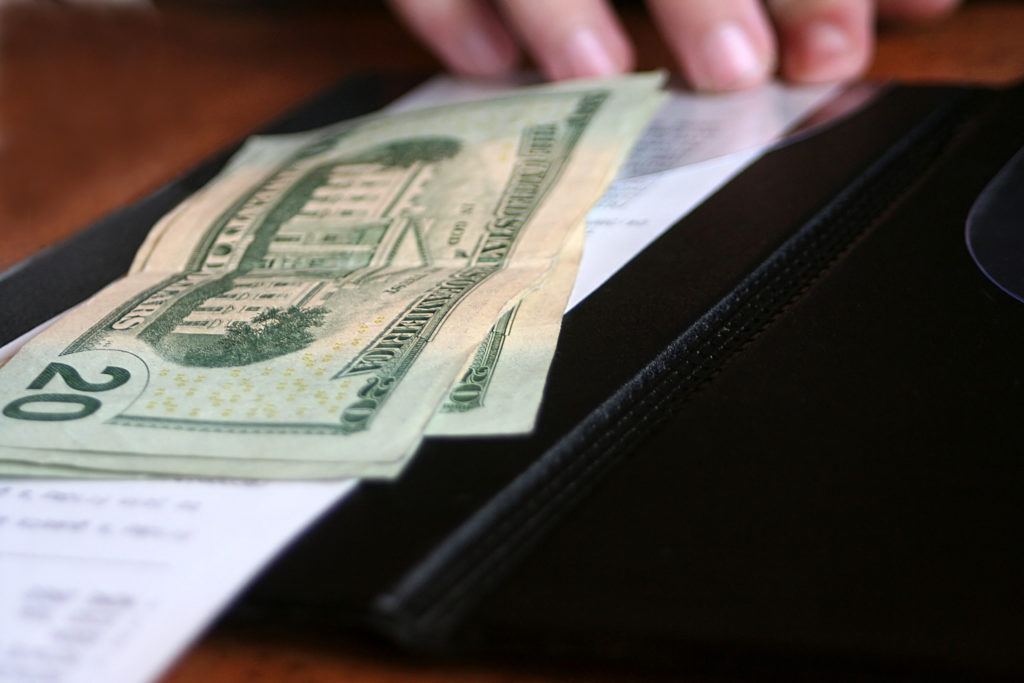
A famous New York City restauranteur – Danny Meyer – has become something of both a hero and a pariah because of how he’s attempting to transform his industry. Meyer first appeared on my radar screen when Dave Richards bought me his book, “Setting The Table,” a number of years ago.
In the book, Meyer talks about the mindset, architecture, and preparation it takes to launch a successful eatery – staffing, training, décor, service, and of course, the content – the food. Yes, the book reads much like what it takes to launch a new radio station.
Meyer’s Union Square Hospitality Group of restaurants are some of the best in the business. And Meyer has gone on to become a celebrity spokesman for the restaurant world, while creating the immensely popular “Shake Shack” chain – analogous to creating a new radio format.
So, when he makes a bold move, you can bet everyone in the business is paying attention. And recently, he’s been challenging the entire system of how restaurant food is priced and how his servers and staff are paid.
He’s moving his restaurants to a “menu pricing” system – which is a more complicated way of saying “no tipping.” Meyer claims that no gratuities translates to a fairer system. Of course, it means a higher-priced menu, but a more honest approach.
As Meyer notes, “People are just as important as food.”
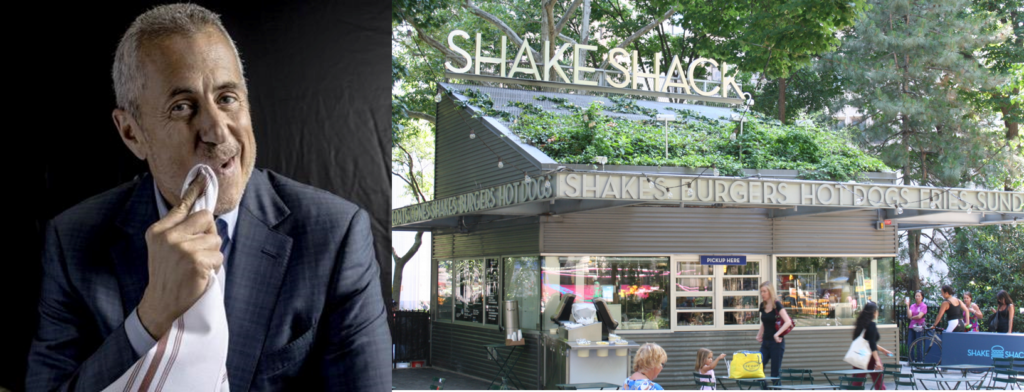
But to change a system that’s been part of people’s lives since the first time they walked into a sit-down restaurant, a little education – and a lot of hand-holding – is required. That has meant teaching (and convincing) his staff, and communicating the same message to his diners.
It’s not an easy task to fix or change an entrenched system that’s been in place for decades. But when an ecosystem is in need of different thinking, it requires courage, commitment – and patience – to pull it off.
And that’s why Meyer’s tectonic shift in the restaurant business should be of more than passing interest to radio sellers, managers, and owners. Because the current system hasn’t really changed since Cousin Brucie, Wolfman Jack,and Wally Phillips ruled the airwaves.
We schedule as many commercials as possible into clusters, and we call it good. In PPM markets, those spots are crammed into just two stopsets – to maximize “meter retention.” But as we noted in yesterday’s post, that business model is being challenged and even undercut by subscription radio services, audio streams, and other alternatives consumers – and advertisers – are adopting and enjoying.
Meyer isn’t just championing a new restaurant compensation architecture – he’s launching a new paradigm that he believes has value. And his “no tipping” venture reminds me of a couple of radio initiatives that are doing very much the same thing:
Challenging the status quo by providing proof of concept.
And it’s a heavy lift. The first of these is a new effort by Suzanne Grimes, president of Westwood One, along with Nielsen. The “ROI Guarantee” initiative 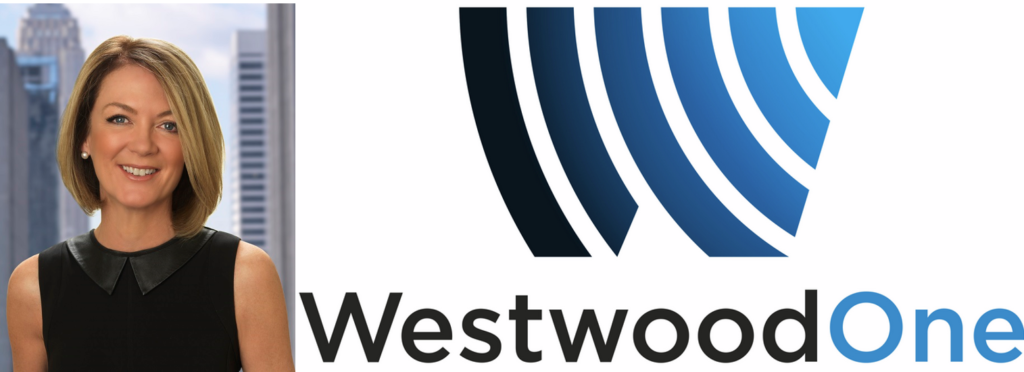 utilizes some of the protocol that Jerry Lee (profiled in yesterday’s post) has espoused: pretesting creative, bolstered by Nielsen measuring a campaign’s return based on its ad spend.
utilizes some of the protocol that Jerry Lee (profiled in yesterday’s post) has espoused: pretesting creative, bolstered by Nielsen measuring a campaign’s return based on its ad spend.
And at the end of that process if ROI falls short, “Westwood One will run no-cost supplemental media weight sufficient to deliver the guaranteed ROI.” That’s directly from their press release.
Grimes, along with Nielsen, is convinced radio can buck advertiser perceptions and deliver results. Like Danny Meyer’s initiative, it’s not just about Cumulus or her network – a positive result will “lift all boats” – in this case, the radio industry. It’s a bold plan that hopefully marketers will test drive.
But like anything new, it comes with obvious risks.
Speaking of which, what about cutting your spot load in half and limiting your commercial breaks to just two minutes? And then guaranteeing it.
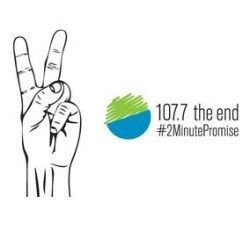 It’s not a guarantee – it’s a promise. And like Westwood One’s maneuver, KNDD/Entercom Seattle felt the need 3+ years ago to go big or don’t bother. The End – as the station is best known as – was listing in the ratings, dragging in sales, and showing signs of distress. That’s when market manager Jack Hutchison and VP programming & ops Dave Richards went all in on the creation of “The 2 Minute Promise.”
It’s not a guarantee – it’s a promise. And like Westwood One’s maneuver, KNDD/Entercom Seattle felt the need 3+ years ago to go big or don’t bother. The End – as the station is best known as – was listing in the ratings, dragging in sales, and showing signs of distress. That’s when market manager Jack Hutchison and VP programming & ops Dave Richards went all in on the creation of “The 2 Minute Promise.”
From there, PD Leslie Scott and her on-air, programming, promotion, production, and digital teams went to work solidifying and positioning this very different concept to a skeptical, jaded audience that had frankly already suffered through many changes and iterations on The End since its birth in the early ’90s.
Unlike Westwood One which is still in the early stages of determining the efficacy of their “ROI Guarantee,” The End has already enjoyed strong results – in the ratings and in sales. Pre-#2MP, the station was hovering in the high teens in 18-49 year-old adult rankings – not a good spot for an Alternative station. Just six months into the initiative, they were in the Top 10. And these days, it’s not uncommon for them to be in the upper echelon of their target demo.
The chart below tracks KNDD’s growth since #2MP was launched (red line). The station’s ratings trajectory has been on a steady uptrend since the initiative hit their air.
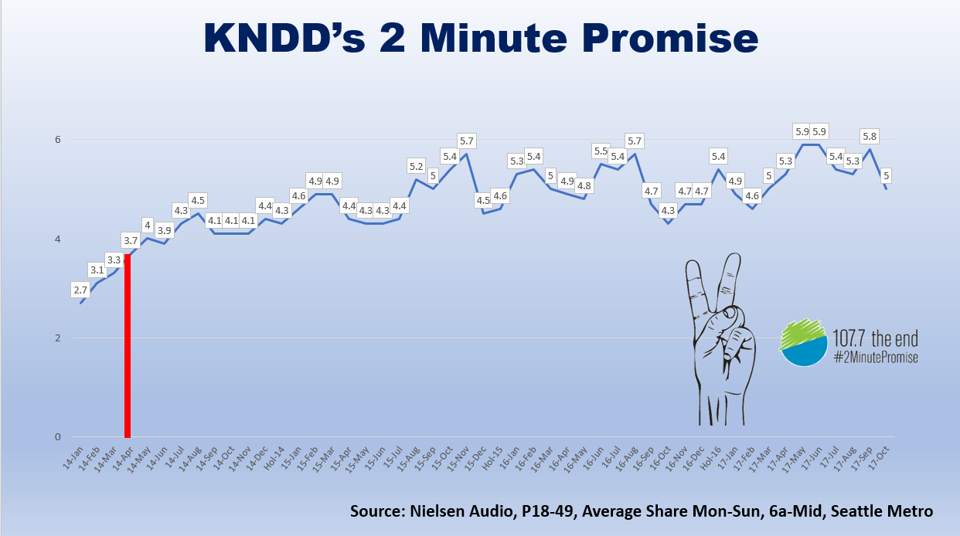
There’s been sales growth as well, but as Jack Hutchison points out, maximizing these great ratings with a limited inventory is a tall order and an arduous task. It requires creative sales approaches, as well as connecting with sponsors and advertisers who “get” the unique commercial environment The End has created.
Sean Pollock serves as the station’s “Millennial Marketing Specialist,” and he’s tasked with making the case that a small spot load and a clean commercial environment is more conducive to longer listening and better results – including the perception that End fans actually listen to the commercials. They’ve put together compelling videos that tell the #2MP story – and they’re persuasive.
https://jacobsmedia.wistia.com/medias/py8us5q0s4?embedType=async&videoFoam=true&videoWidth=640
But you’ll notice there aren’t a dozen other stations around the country – or even in the Entercom group – adopting this tactic. Like Danny Meyer’s “No Tipping” strategy, you’re probably not dining at restaurants bold enough to launch a game-changer of this scale and risk. Like those Olympic dives with a “high degree of difficulty,” these initiatives aren’t for the mild, the meek, or the followers.
So what do Danny Meyer, Westwood One, and The End have in common?
They believe.
They believe in their industry. They believe in their brand. They believe in the value of their product and service. They believe in change.
And they believe there’s a better way.
So much so that they’re willing to take a make a big commitment and take an even bigger risk in order to demonstrate the efficacy of their idea.
As Danny Meyer has proved throughout his career, there is no one way to run a restaurant.
And there’s no monolithic way of selling spots, setting advertising limits, or designing clocks.
Anybody in radio could do this, but few actually will.
At a time when the industry needs to step up and find new, different, and innovative ways to skin that commercial cat, who else will walk up to table and go “all-in?”
And remember, no tipping.
- What To Do If Your Radio Station Goes Through A Midlife Crisis - April 25, 2025
- A 2020 Lesson?It Could All Be Gone In A Flash - April 24, 2025
- How AI Can Give Radio Personalities More…PERSONALITY - April 23, 2025




Here at independent radio station, Radio Woodstock, we have had great success since limiting our hourly commercials to 10 minutes and stop sets to no longer than 2.5 minutes. It not only creates a better listening environment but also a better environment for getting across the marketing message of our advertisers. We let listeners know that commercial breaks will be no longer than 2.5 minutes before each break.
We also frequently thank our local businesses on the air for supporting us which builds a positive image for individual advertisers and advertising overall with our listeners. This is an important part of what we do. We stimulate the idea that advertising is not an intrusion to listening to our programming but valuable product/service information of local businesses for goods and services that our listeners need in the short and long term. This approach helps our TSL and gets better overall results for our advertisers.
On the business side, advertisers appreciate what we are doing especially since the other stations in the market are all part of national radio groups and run 14 to 16 minutes an hour with 6 to 8 minute stop sets. We all know that after the third commercial in a stop set that the effectiveness of the ad drops significantly. They also low-ball rates. What we are doing enables us to maintain our unit rate integrity, provide a better listening experience and a more productive advertising environment. We are up 8% this year.
And finally because our listeners understand why we are doing what we are doing, they are willing to support Radio Woodstock as well. We run listener fund drives twice a year that has become a major revenue stream. It’s the Woodstock Way and it’s working. Peace, love, radio.
Caring about the listener experience–what a concept!
Sounds like you’re doing a fantastic job! Congratulations and continued success to you!
And if I can steal a line from you, I’ll close by wishing you three of my favorite things in life:
Peace, love, radio.
David
Richard, Radio Woodstock has staked out the perfect course, given your brand, your history, and the makeup of your market. The piece about thanking your advertisers as well as your audience (with a cleaner commercial environment and a better experience) is an important one. Thanks for relating the story, and continuing to be pioneers in New York State.
And, most importantly, what these paradigm-shifters believe in is the intelligence of the audience. A listener treated with respect will respond with appreciation.
When we create commercials for the clients of the broadcasters we serve, we keep that in mind, and the results are refreshing. With a lower spot load each message must engage more effectively. More engagement means more ROI for clients which means less attrition and more repeat advertisers. It’s a powerful cycle.
Jeffrey, that’s a strong point. The audience has to “get it” and believe it’s true. In the case of KNDD, that was one of the barriers as the station – despite being in the same format for two decades – had changed things up time and time again. The intelligence of the audience mattered, but so did a steadfast commitment to staying the course and not changing…again. Thanks for the insight.
Blended comments from yesterday’s and today’s columns.
1) Its amazing how little control there is over radio ads – quality, number and clustering. Advertisers are paying to be there and its almost as if radio is trying to devalue what they get for their money. 5, 6 and 7 minute stop sets are absurd and an ROI guarantee for the ones running at the back end would be really expensive, Has anyone studied the % of people who are gone at the end of a 6 minute stop set?
2) Dick Orkin notwithstanding, radio ads were mostly bad even in the good old days. How many “if you’re looking for a great place to buy ______, why not check out _______ located at _________? They have a great selection of _________, ___________ and even _________ at some of the lowest prices in town. For all your __________ needs, stop by _________ at _________, or call them at ___ ____. Mention you heard about them on______ and receive a 5% discount” ran back then? Now, most radio ads are supplied by the client, so there is only so much control a station can exercise.
3) How much do radio salespeople actually know about what makes radio ads effective? Does anyone at most radio stations know? If the overworked production people had time to create better spots, would they know how to do it? That would be a good place to start – every seller and producer of spots should be required to learn and follow the Jerry Lee model. FWIW, the tradition of salespeople writing ad copy always seemed ridiculous to me.
4) I’m all for and a big proponent for making radio ads better and more effective, but my gut is that the number of units and the length of stop sets is a bigger problem right now. When “The End” cut back its spotload did they make any other changes, or is their ratings growth purely due to that? If so, it lends support to my opinion. I wonder if every station did what The End did if overall PURs would go up?
Loved your whole comment but especially had to laugh out loud at your ready-made “mad-lib” fill-in-the-blank commercial! And if you don’t believe me, just call me at ________________. That’s _____________. Again, ___________. Call today. _____________!
Bob, thanks for fueling more conversation on this topic – an important one for the radio industry to be having. It took years to get to this place, and it will take time to dig out of it. I have hope that others will be inspired by The End and WW1 (as well as some of the commenters), and consider a new architecture and other innovations. But as you suggest, the talent, investment, and training in commercial production would be a giant leap forward (as I listen to some of the worst ads on the “radio” on SiriusXM). Appreciate the comment.
Loved the video promotion for #2M. Really says it all.
Reminds me of how some grocery stores started adopting a “three’s a crowd” policy with their checkout lines. If three people are in line, they’ll open another checkout. Who hasn’t known the frustration of being in a long line at a bank or store, only to see one or two people helping the customers?
#2M strikes me the same. It treats you as an adult–because we all understand the bills have to be paid–but also says we care about your experience if you’re one of our customers.
Congratulations to Suzanne Grimes and The End for some great forward-thinking. I wish them both much success.
Now will others follow the lead?
Here in Lexington, we took on a “heritage” rock station in the market with the “3 Minute Promise”… We have achieved the same kind of results as Seattle.
This is not for the faint at heart. My owner wasn’t so convinced, but went for it under the guise that once the numbers came back up, we’d re-consider.
Now that listeners, associates and ADVERTISERS tell us time and time again that they love the “3 Minute Promise” (BY NAME), our owner is leading the charge.
It is a great tool for a sales person, as they can tell the potential client that their message doesn’t get lost in 7-12 minutes of commercials.
Local-direct seems to gravitate to buying time on our station more than the agencies.
You have to keep the imaging fresh and relevant in and out of the break and drive it home!
FYI, make sure you service mark it!
Max, this is a great story. And it shows the road to success is not an easy one. But a bold plan, backed up strong execution, and belief can pay off in radio. Thanks for the comment.
Why is it revenue can only come from selling air time? Why not take advantage of station websites and mobile apps as a tool to retail the stuff that gets advertised? Or for that matter, even stuff that isn’t? Stations could easily reduce spot loads by half? two thirds? (Two 2-minute breaks an hour, anyone?) and make it up and then some, by using the station’s website/app and either rent pages, get paid to produce content on behalf of clients, and/or get paid a commission for every unit the station sells on behalf of their advertising clients.
Imagine then a station with low spot load, yet ads of steller quality that listeners not only tolarate but actually enjoy as an integral part of the programming. Seems to me TSLs go up, advertiser results improve, station bottom lines get bigger — everybody wins. Yay!
And for the record, it is possible to make radio commercials that get requested (just like records) and generate sales for the advertiser. I know. I’ve done it.
I like that environment you’re talking about, Peter. I believe that many radio companies are attempting this (on one level of another), but it’s hard to break away from standard operating procedure, especially when you’re on investor conference calls every quarter. Trying to fix the plane while it’s at 35,000 feet is the challenge, as well as competing with a much wider scope of players. And your last thought – yes, commercials on the radio can entertain. It’s just been a long time since they have. Thanks for the comment.
Now that I’m out of day-to-day radio operations and have not stake in the stations in my local market, I’ve been sampling streaming services and satellite more often than not. I have to say that Pandora’s limited commercial interruptions are great, not only for my enjoyment of the programming but also for my retention of the sponsor messages. As a former radio creative, the idea of 2-3 minute stopsets means few units to produce and more time to craft better quality messages that can be understood by and connect with the audience. Want to generate more revenue? Charge a premium for first position in the break. That’s what I’ve come to believe as I live the life of the audience from my new position of “radio-adjacent” freelance producer.
Drake, thanks for this. You definitely hear a very different sounding radio station when you listen to The End. I would encourage others to sample the station and then think about the state of radio where you live. The contrast is a stark one, perhaps preparing KNDD for the battles against digital competitors of today and the future.
When The End begin their two-minute promise, I was very excited to see the results. I’ve seen other people try it, but fail because they couldn’t continue doing 2 minute commercial breaks. The fact that they’ve kept it going this long and have had results is a testament to a company-wide commitment. Because at the end of the day, most companies think adding units means adding Revenue, while lowering the per unit value. What they fail to realize, limited units increases the rate…supply and demand paradigm.
I have always been curious to see if anybody ever attempts to do a full product-placement style advertisement in terrestrial radio to combat satellite radios “no commercials” promise. KZPS did this about 10 years ago, when they attempted Americana, but I think the format was wrong that they attempted it with. Curious to see if anybody ever tries that again with a more mainstream format. Something tells me there will be a huge upside. Until then, most companies would be too scared to attempt it. Short-term losses would outweigh way long-term gains.
Steve, thanks for the comment. As you point out, KNDD has made the sacrifice and paid the price to blow up its commercial model. Thanks to the support of Entercom and the local Seattle team, they’ve stayed the course, realizing they could not break trust with an already jaded audience. The result is a station that is unique to Seattle, not just because it plays Portugal The Man, but also because they are different from everyone in the market because of their clean, listener and advertiser friendly commercial environment.
Here’s a softball… When will ‘terrestrial’ re-align & incorporate digital technology, 2 way, real time feedback loops, to know exactly who is listening, where they are? Why fear the medium of ‘new’ radio? A Great thread above. Yes, jumping out that trench was almost a certain death. It required someone to blow the whistle, or not.
Looking at beta SXM ‘discovery’ features in dash. 2 way has been a headwind for SXM and OTA. SXM beta discovery is a Pandora/Spotify ‘lite’ – subs press the ‘star’ next to a song title and/or artist; this programs their personal favorites. Then with no action ‘a flag’ pops on the screen, in dash, if a fav song or artist is playing. When you press the flag; it allows you to jump to the content. Another new sub menu is for ‘discovering’ other music, or a content genre a sub might enjoy. This is pre 360 beta and clearly a long game, 360L. It increases ‘value’ for those 27-32mm laying out big money with promising new methods waiting to captivate passengers. That will be the Video content … tbd. ^ It is new revs for the auto industry, who will they split with ??? SXM .. Infotainment ‘app’ firms, radio? FaceBook?
There is NO chance that the auto industry passes up these connected revenues; its money falling from the sky. ‘The Fog’
(New buzzword for a cloud to wifi omnipresence).
Radio is not excluded, radio ‘just’ needs to participate. 2 way, RT dynamic placements . Local is spending for it already. It’s always mentioned there needs to be willingness AND fresh blood, essentially, open to mentorship for ‘radio’. Man, what a dream job that would be!
A most cited reason Instagram or Groupon sells local ads = they make them… it’s very easy, they prove ROI with immediate feedback. One can also change these ads on the fly, say correct the price if demand spikes, per example. The largest generations are only just now in the sweet spot. Boomers remain crucial, no doubt, are also adopting.
Real life example. I’m at a well known retailer. I have their app downloaded & activated. Most 40/45 under are conditioned to do this when entering a store, many 65 do it too. Why? Well, it’s the best way to get the best discount. Naturally. Consumers learn faster than ever. Under 37-40 is a no brainer.
So, ‘they’ know where I am; inside store x357 and it’s ok, ‘they’ would know, anyway. Modern day consumers activate a stores app before going like we all used to Pre-Shop or price compare on Google.
The store knew every step we took, what was looked at, for how long, who was with me, even what they browsed. Next time you are at a Giant, Target or Gap – look up at the sensors! Ok… We pick our goods and are in line. I was fine, but at 10 minutes, with a little one luckily behaving, but only one register is working. It’s the retailer Nightmare… will this all become lost sales? Nope!!
They sent me a push notification for 50% off!! All on the fly while I’m literally standing in line! They knew exactly how long we were in line, so strange at first. The line stirs… how did you get that discount? What’s the code? Do tell! So, We tell. All in line start downloading or activating the app to hopefully get the same discount. They did. A manager steps out; apologizes individually to the entire line, and proceeds to check us all out with an iPad. This is the ‘holy grail’ for a successfully placed dynamic, real time, interactive ad. Manager then handed us another discount; for the next visit. And digitally another apology that evening. Wow. How much more can radio charge for this type of ad? Or will FB take all of the share w/ Insta? $14.2-17.3 Billion $ ?
I asked them a lot of questions; it felt too powerful; a reality show stunt. I knew about beacons (radio can use these). Turns out they were running a test on a ‘next generation’ CRM ‘Smart’ technilogy to retain and attract sales. That was 2 years ago. The firms stock has rebounded tremendously, against the grain in the tanked retail sector. The technology along with substantial merchandising quality changes; (content) and closing the poor stores reopening in better studied locations fueled via technology, hyper local information en mass.
Maybe this experience puts the power of ‘digital’ into words that paint a picture easy to relate with… if not, thanks for reading this very long comment…. Peace. Love. Radio.
Josh, I don’t know where to begin, but this comment is worth more than me just dashing off a few brisk lines. The overriding issue of when radio truly embraces its digital potential is in the crosshairs here. And your comments about SiriusXM echo what we’ve been saying in recent posts. Interactivity, advertiser connections, and demonstrating value as a medium and as brands are what’s at stake here.
The radio industry hasn’t had to provide proof of concept since perhaps the ’50s when television came along. Or maybe it was even decades before that when the medium first started rolling out, first in homes, and then in cars – and everywhere.
The beacons issue is an interesting, and one that’s been in play for some now in our mobile apps division, jacapps. There are a lot of moving parts here – broadcasters, retailers, etc. – but as you suggest the potential to connect radio with smartphones and retailers is not just attractive, but it’s where the shopping puck is headed.
Again, I appreciate this comment and the brain power behind it. It’s stimulating, and what I enjoy about writing this blog. Thanks for taking the time.